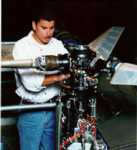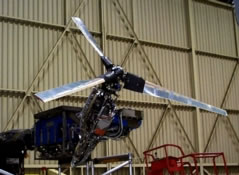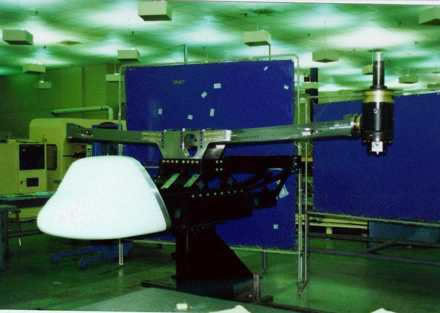TRAM Project Details
Tiltrotor Aeroacoustic Model
The Tiltrotor Aeroacoustic Model will be used as a test bed for testing moderate-scale tiltrotor models in two different test configurations in different research facilities: (1) Isolated Rotor testing at the Duits-Netherlands Windkannal (DNW) in The Netherlands; and (2) Isolated Rotor and Full-Span testing at the National Full-Scale Aerodynamic Complex (NFAC) at Ames Research Center.

Duits - Nederlandse Windtunnel
A checkout test of the Tiltrotor Aeroacoustic Model (TRAM) isolated rotor test stand is currently being conducted in the National Full-Scale Aerodynamics Complex N246 Model Preparation building. The checkout testing includes the acquisition of hover data -- including rotor airloads data -- for a 1/4-scale set of proprotor blades using the NFAC NPRIME data acquisition system. Key test stand capabilities being checked out include a Nationaal Lucht-en Ruimtevaartlaboratorium (NLR) developed rotating amplifier system (RAS) and the MFEDS real-time safety of flight monitoring system. A considerable amount of infrastructure build-up -- including armor plate shielding and control room installation -- was required in N246 to enable TRAM functional testing.

The full-span version of the TRAM test stand is also being concurrently developed. Fabrication of full-span model development is underway and the bulk of the hardware was delivered in June 1997. A new generation rotor control console for the isolated rotor test and the full-span model is also in development; delivery of the console is scheduled for the end of March 1997.
The 1/4-scale TRAM rotors and airframe are based on the V-22 Osprey tiltrotor aircraft. The TRAM test stand will also be an advanced technology demonstrator platform for the Short Haul Civil Tiltrotor (SH(CT)) program, a sub-element of the Advanced Subsonic Transport (AST) initiative. Both Boeing and Sikorsky Aircraft have been contracted by the NASA SH(CT) program to develop interface hardware to test a new generation of small-scale, advanced proprotors on the TRAM test stand. The Boeing and Sikorsky proprotors are planned to be tested on the full-span TRAM test stand in the NFAC 40- by 80-Foot Wind Tunnel. The full-span TRAM proprotor testing is currently planned for FY 99-01. Larry A. Young, (650)604-4022.
- TRAM Objectives
- Description/Capabilities of TRAM (Isolated Rotor)
- Description/Capabilities of TRAM (Full-Span)
- DNW/Isolated Rotor Status - Motors & Motor Drive/Controller
- DNW/Isolated Rotor Status - Rotor Control Console & Actuators
- TRAM Represents Next Wave Rotorcraft Test Technology
- Current/Future Spin-Off Successes
- Industry Technology Transfer
A Brief Recap - TRAM Objectives
 A Brief Recap - Description/Capabilities
of TRAM (Isolated Rotor)
A Brief Recap - Description/Capabilities
of TRAM (Isolated Rotor)
A Brief Recap - Description/Capabilities of TRAM (Full-Span)

DNW/Isolated Rotor Status - Motors & Motor Drive/Controller
DNW/Isolated Rotor Status - Rotor Control Console & Actuators
TRAM Represents Next Wave Rotorcraft Test Technology
Current/Future Spin-Off Successes
Industry Technology Transfer
Point of Contact:
Larry Young
NASA Ames Research Center
Moffett Field CA 94035-1000
U.S. Rotorcraft Company links
Other V-22 links
- Air Force Technology Today
- Boeing's V-22 Osprey Site
- Bell Helicopter's V-22 Site
- U.S. Navy's V-22 Osprey Site
- Helicopter History V-22 Site